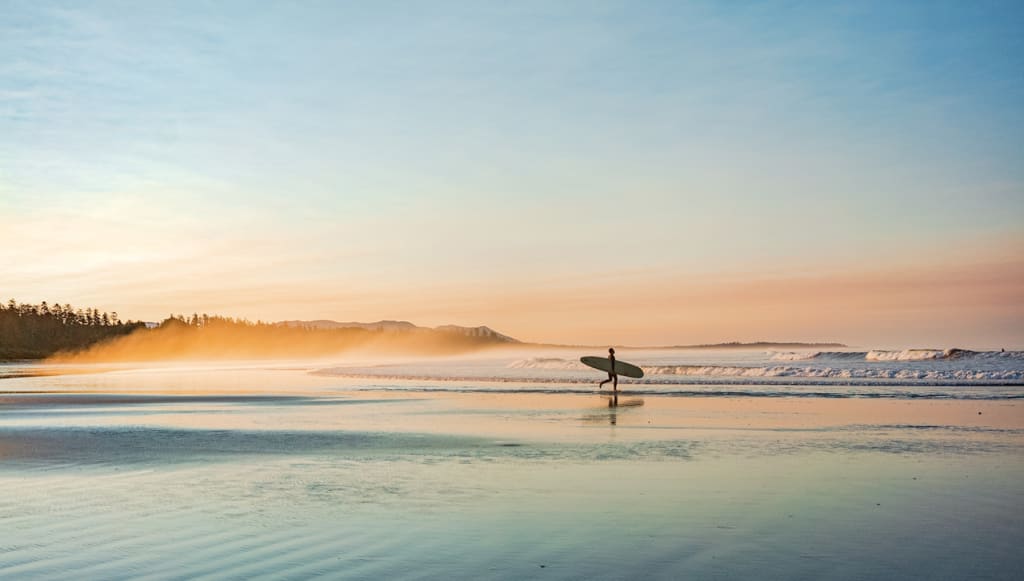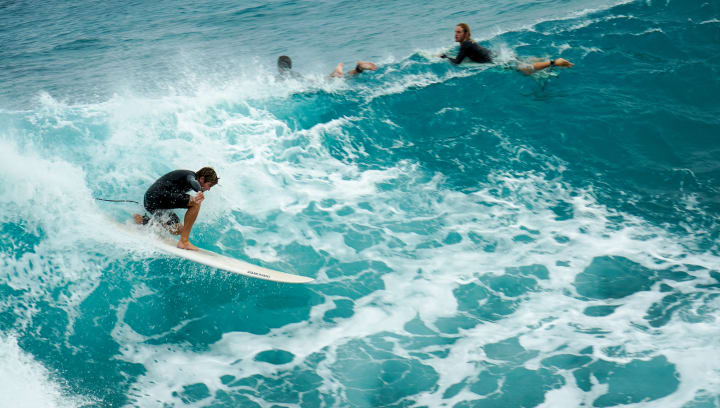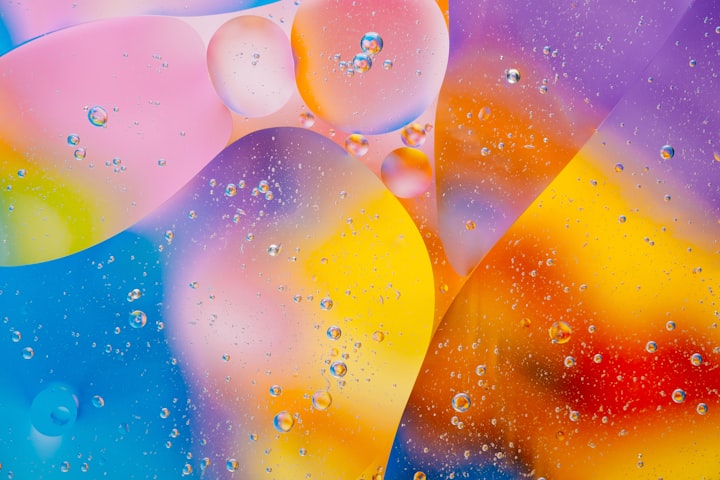Surfing bipolar. Note #1.
An introduction to my journey of surfing and living life with bipolar disorder.

Hello,
I’m Varvara. I am a coder, designer, artist, mom, wife, storyteller, surfer, and I have bipolar disorder. One day, I hope to write a book about my experience of going through life with bipolar disorder. In the meantime, I’m starting with a smaller step: writing monthly articles on the connections between surfing and bipolar disorder.
“Bipolar disorder is a brain disorder that causes changes in a person's mood, energy, and ability to function.“ (1)
These articles are going to be a self-exploration, a learning-by-doing journey of three worlds: surfing, living with bipolar, and the writing process—all shared with you, friends, my readers ♥.
I like to say that I’m surfing my life with bipolar disorder daily, and the actual ocean surfing happens less frequently.
I consider my experience levels as:
- novice in surfing (<1 year, I barely stand on a surfboard in shallow waters - for now),
- intermediate in writing (> 5 years, I wrote one book for my sustainable fashion Master thesis and many personal journal notes),
- experienced in bipolar disorder (~ 20 years of understanding my bipolar mind through personal experience and reading research, but I’m not a scholar, doctor, or researcher of mental health in any way).
“If you think you can learn a lot from reading books, try writing one” - James Clear.
I have lived with bipolar disorder mood swings since high school, and have loved the idea of ocean surfing for just as long. In 2013, I was officially diagnosed with bipolar disorder. It wasn’t until 2019 when circumstances aligned for me to actually try surfing for the first time.
I often read how athletes or people who are into sports find life lessons in the process of their practice. I run, bike, swim, do yoga and high-intensity exercises, and even though all of those activities have physical and mental benefits, as well as life lessons, surfing in particular gives me the best picture and language to describe the many concepts I live with while having bipolar.

North Pacific Ocean, specifically Tofino, Vancouver Island, is where my surfing journey started. Tofino’s Long Beach is where I feel the most content and fulfilled, no matter the state of my bipolar moods. Most of the thoughts for this series of articles have been formed at the beach getting ready to meet my first waves, or in the ocean catching or being crushed by those same waves.
“Bipolar disorder (previously called manic-depressive illness) is a medical condition that involves changes in brain function leading to dramatic mood swings. These mood swings can be so severe that they impair normal functioning at work, at school and in relationships.” (2)
The changes in mood states that come with bipolar disorder are usually called episodes or mood swings. I actually think that comparing the episodes to waves, instead of swings, makes more sense.
The main problem I have with the swing analogy is that the motion of a swing is controlled by the one swinging. Swings are something I can easily control, because I know the physics involved in swinging. I can control the speed and highest point by changing my body movements. I can follow someone else’s example, or simply ask a friend to help me swing. Bipolar disorder doesn’t feel or work like that.
“People with bipolar disorder experience intense emotional states that typically occur during distinct periods of days to weeks, called mood episodes. These mood episodes are categorized as manic/hypomanic (abnormally happy or irritable mood) or depressive (sad mood). People with bipolar disorder generally have periods of neutral mood as well.”(1)
In addition, the comparison to swings implies that the high and low mood peaks are opposite sides of the spectrum, repeating: back and forth, back and forth.
This would mean that the manic episodes mirror the depressive ones in length and intensity, and come predictably one after another. And that in between these two high points, when the swing falls to its lowest point close to the ground, there is an always fleeting balanced emotional state. I sometimes think that the swing analogy might be implying that the depressive state is ground level, and the manic states are the high points you reach when you’re swinging. But when I’m on an actual swing, the ground level feels like the most stable place to be. This sense of stability is far from the feeling anyone who’s ever had a depressive episode feels.
“For people with bipolar disorder, (these) normal emotions can become a roller coaster ride of wild highs and devastating lows. Moods are driven, not by the events of life, but by a force of their own.”(2)
I wish I could control my moods like I can control a swing, where I move back and forth between potential and kinetic energy(4). I wish the more intense my mood swing was, the higher the swing would be, and the more energy I’d have to later transform into a positive action. This is kind of what it’s like during a manic episode; I feel like a great energy reservoir ready to explode. But this isn’t what depressive episodes are like. During this mood state, I experience extremely low levels of mental and physical energy, and the only potential I feel is for self-destruction.

Ocean waves are created by wind blowing over the ocean, a natural phenomenon that humans study but can’t control. This sounds simple, but there are many kinds of waves and the specifics of wave formation are complex, like with bipolar disorder. However, right now the world knows much more about the nature of ocean waves than the nature of bipolar disorder.
I will dive more into the specifics of bipolar disorder and ocean waves in my next article. But I prefer to describe my moods as waves, because I see mood ‘waves’ as a force that happens to me, the opposite to ‘swings’ which I move myself. In general, bipolar disorder’s changes in mood, energy, and ability to function are not something I choose to have or can control myself. Some complex chemistry in the brain related to inner or outer triggers forces me to switch from one state to another, from the high energetic states to the low depressive ones.
“Although the exact cause of bipolar disorder is unknown, it is thought that several factors, such as genes, brain structure, and stress response and management, could play a role in how often symptoms occur, how severe they become, and how long they last.” (3)
Mood waves are something I have to handle on a daily basis, and the better I understand their intensity (or force, using ‘waves’ language), magnitude, and direction, the better I can handle them. Without much experience, self-awareness and knowledge of the disorder, someone with bipolar can’t even predict when a wave is coming. And when a big one comes unexpectedly, they either fall from the highest point of the wave (the crest) or are crushed by the wave while in its lowest point (the trough).
I’ve been in both situations with my bipolar disorder journey. I’ve put myself in danger while at the crest during a manic episode. And I’ve almost ended my life while being crushed by the heavy weight of a depressive episode lip(5)*. Luckily, I came out of both experiences alive. Both are engraved in my memory as the scariest and hardest events of my life. These memories push me daily to learn to ‘surf the ocean’ of my bipolar mind, so that I can manage my mood changes safely for myself and people around me.
“When treated, people with bipolar disorder can lead full and productive lives.”(1)
I’m learning that I can use my arms to control how fast I approach the waves. I’m learning the best standing technique and how to move with the waves. I’m learning to study the ocean, prepare for coming waves, and identify which ones are manageable. I’m getting better at understanding which waves I can try to ride and balance, and the ones I need to paddle through in order to make it safely to the other side. The same goes for living through bipolar mood waves. My ultimate goal is to stay in a balanced state, and make this life ride enjoyable for myself and the people who choose to be with me in these unpredictable waters.
“Certain lifestyle and environmental factors can also trigger or aggravate the extreme highs and lows...Once you’re aware of these triggers, you can gain better control over your disorder.”(3)

Nowadays, the episodes—waves—I experience are easier to predict, handle and live through without my life being disrupted by it. This is the positive outcome of my investment in self-learning, therapy and the right medications. The waves come and go, but now I’m more in charge of how I ride them. They move me through life. Some speed me up, and some slow me down. Some last longer, some pass easier, some feel routine, and some affect my life more than others. Some lift me up; some crush me down—but without life-threatening extremes. With time, experience, help, and the right tools, I’m learning to ride the waves, become a better surfer, and I’m even learning to enjoy the ride.
More on that in next articles. Thank you for reading. Talk soon.
Yours, Varvara ♥
___________________________________________________
Collaborators:
- This article was copyedited with help from Carmel Kundai
- The photographs in the article are taken by Mira Ocean and can be purchased at https://miraocean.com/
___________________________________________________
Notes:
- "Bipolar disorder is a brain disorder that causes changes in a person's mood, energy, and ability to function. People with bipolar disorder experience intense emotional states that typically occur during distinct periods of days to weeks, called mood episodes. These mood episodes are categorized as manic/hypomanic (abnormally happy or irritable mood) or depressive (sad mood). People with bipolar disorder generally have periods of neutral mood as well. When treated, people with bipolar disorder can lead full and productive lives." (Source: American Psychiatric Association)
- “For people with bipolar disorder, (these) normal emotions can become a roller coaster ride of wild highs and devastating lows. Moods are driven, not by the events of life, but by a force of their own. Bipolar disorder (previously called manic-depressive illness) is a medical condition that involves changes in brain function leading to dramatic mood swings. These mood swings can be so severe that they impair normal functioning at work, at school and in relationships.” (Source: Mood Disorders Society of Canada)
- “Although the exact cause of bipolar disorder is unknown, it is thought that several factors, such as genes, brain structure, and stress response and management, could play a role in how often symptoms occur, how severe they become, and how long they last, according to the National Alliance on Mental Illness (NAMI). Certain lifestyle and environmental factors can also trigger or aggravate the extreme highs and lows, known as bipolar episodes, which are a hallmark of the condition. Once you’re aware of these triggers, you can gain better control over your disorder.” (Source: Everyday Health)
- Notes on swings: "Motion which repeats itself after certain intervals is called periodic motion. Since the motion of a swing also repeats after regular intervals so the motion of the child on a swing is periodic." “Swings work by converting potential energy into kinetic energy, then kinetic energy back into potential energy, over and over again. The kinetic energy is the fast part of swinging; it's the speed you have as you rush back and forth. Potential energy is the high part of swinging. The higher you go on the swing, the more potential energy you have.” (Source: Moment of Science).
- Lip: The top part of the wave that “pitches” from above when the wave is breaking. A big part of the wave’s power is located in the lip. Impact Zone: The spot where the lip crashes down on the flat water. You want to avoid getting caught in this zone when sitting or paddling our to the surf, as this is where the wave has most of its power. (Source: Barefoot Surf)
___________________________________________________
*the author is writing from personal experience living with bipolar disorder and learning to surf. For any clinical information or if you/somebody you know is struggling with the weight of bipolar disorder, depression, or another aspect of their mental health, please reach out to a professional. Same applies to surfing--please search for professional channels to learn surfing.
About the Creator
Varvara
Hello







Comments
There are no comments for this story
Be the first to respond and start the conversation.